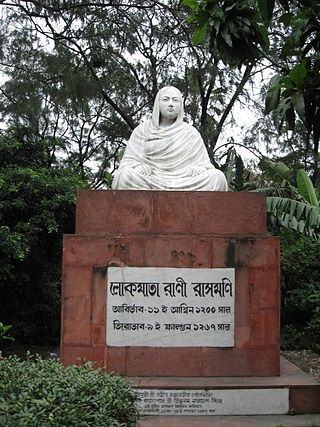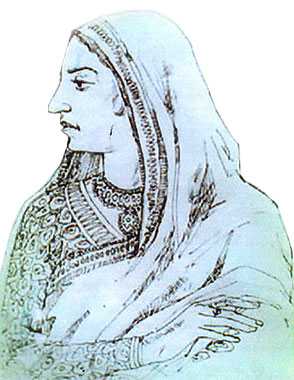
Mymensingh District is a district in Mymensingh Division, Bangladesh, and is bordered on the north by Meghalaya, a state of India and the Garo Hills, on the south by Gazipur District, on the east by the districts of Netrokona and Kishoreganj, and on the west by the districts of Sherpur, Jamalpur and Tangail. Mymensingh is the 8th administrative divisional headquarter and 12th city corporation of Bangladesh. According to Ministry of Public Administration, Mymensingh is ranked 4th in district status. The density of Mymensingh city is 44,458/km2 which is the second most densely populated city in Bangladesh. Mymensingh attracts 25 percent of health tourists visiting Bangladesh. Once known as the largest district of the Indian subcontinent. Mymensingh town is the district headquarters.

Rangpur District is a district in Northern Bangladesh. It is a part of the Rangpur Division.

Rashmoni Das, popularly known as LokamataRani Rashmoni, also spelled as Rani Rasmani,, was an Indian businesswoman, entrepreneur, Zamindar, philanthropist and the founder of the Dakshineswar Kali Temple in Kolkata. She remained closely associated with Sri Ramakrishna Paramhansa after she appointed him as the priest of the Dakshineswar temple. She was also one of the earliest social reformers in early nineteenth-century Bengal and was one of the forerunners of the Bengal Renaissance. Besides, she also led many of the resistances against the encroaching British administration and their presence in all walks of colonial society in the Bengal province. Her other construction works include the construction of a road from Subarnarekha River to Puri for the pilgrims, Babughat, Ahiritola Ghat and Nimtala ghat for the everyday bathers at the Ganges. She also offered considerable charity to the Imperial Library, and the Hindu College.

Nabadwip, also spelt Navadwip, anciently Nadia or Nudiya, is a heritage city in Nadia district in the Indian state of West Bengal. It is regarded as a holy place by Hindus, and is the birthplace of Chaitanya Mahaprabhu. Famous for Rass festival where city is illuminated with lights, deities of God and goddesses are made on each corner of Nabadwip town. Hundreds of people gather to this small town on the occasion of raas utsab. Located on the western bank of the Hooghly River, it is considered to have been founded in 1063 CE, and served as the old capital of the Sena dynasty. A center of learning and philosophy in medieval India, the city is still noted for its traditional Sanskrit schools. The Navya Nyaya school of logic reached its peak with the efforts of some well known contemporary philosophers of Nabadwip. The great Vaishnava saint, social reformer and an important figure of the Bhakti movement, Chaitanya Mahaprabhu (1486–1534) was born here. It was after Chaitanya Mahaprabhu's birth that Nabadwip became an important center of pilgrimage for the Vaishnavas worldwide as well as for Hindus in general. Many who follow Gaudiya Vaishnavism visit Nabadwip to celebrate the auspicious birthday day of Shri Mahaprabhu, which, as per lunar calculations, occurs on Phalguni Purnima. This day is commonly known as Gaura-purnima. Aside from this, Nabadwip is visited for various other festivals like Dol Jatra and Rash purnima.

Bhawal Estate was a large zamindari in Bengal until it was abolished according to East Bengal State Acquisition and Tenancy Act of 1950.

Pirganj is an upazila of Rangpur District in the division of Rangpur, Bangladesh. Pirganj Upazila area 411.35 km2, located in between 25°18' and 25°31' north latitudes and in between 89°08' and 89°25' east longitudes. It is bounded by Mithapukur Upazila on the north, Palashbari Upazila on the south, Ghoraghat Upazila and Nawabganj Upazila on the west, Sadullapur Upazila on the east.

Ghughudanga Zamindar Bari was the residential palace and place of business of the Ghughu-danga zamindar family. It is situated on the banks of the Purnobhoba River in Dinajpur District. The palace was destroyed by Pakistani soldiers in the 1971 Bangladesh Liberation War.

Hemchandra Chowdhury (1833-1915) was a Hindu Zamindar in Gopalpur Upazila in Tangail in what is now Bangladesh.
Kali Babur Bari is located in Janai, Hoogly, West Bengal.
Unlike some other religions, Hindus are not required to undertake pilgrimages during their lifetime. However, most Hindus go on such journeys to numerous iconic sites including those below:
The Muktagachha Shiva temple is a twin temple located outside the Rajbari of Muktagachha, located in the Mymensingh District of Bangladesh. The temple was constructed in 1820 by Rani Bimola Devi, the mother of Maharaja Shashikantha Acharya Choudhary, the Zamindar of Muktagachha. The twin temples consist of the Shree Shree Anandamoyi Shiva and Kali Mata Mandir. The Hindu Rabidas community performs a two-day-long Kattyani Puja, locally known as the 'Shat' Puja, in the Bengali month of Kartik. The temple is in dilapidated condition due to a lack of repairs.
Pabna Peasant Uprising (1873–76) was a resistance movement by the peasants ("Ryots") against the lords of the lands in Bengal ("zamindars") in the Yusufshahi pargana in Pabna. It was led by Ishan Chandra Roy, Ishan Chandra Roy is known as "Bidrohi Raja"(বিদ্রোহী রাজা) or in English "Rebel King". It was supported by intellectuals such as R.C Dutt, Surendranath Banerjee, Bankim Chandra Chatterjee, etc. It was overall a peaceful movement.

Nawab Begum Faizunnesa Choudhurani was Zamindar of Homnabad-Pashchimgaon Estate in present-day Comilla District, Bangladesh. She is most famous for her campaign for female education and other social issues. In appreciation of her social work, in 1889 Queen Victoria awarded Faizunnesa the title of "Nawab", making her the first female Nawab in South Asia.

The Greater Jessore region predominantly includes the districts of Jessore, Jhenaidah, Narail and Magura in Bangladesh, as well as the Bangaon subdivision of India. Nestled close to the Sundarbans, the region experienced human settlement early on. It served as the capital city of the Samatata realm and passed through several Buddhist and Hindu kingdoms such as the Palas and Senas. Jessore was ruled by Khan Jahan Ali of Khalifatabad, under the Muslim Sultanate of Bengal, who is credited with establishing the Qasbah of Murali and urbanising the region through advancements in transportation and civilization. Jessore later came to be ruled by various kings such as Pratapaditya and became familiar to contemporary European travellers as Chandecan before being annexed to the Mughal Empire in the seventeenth century. By 1757, the British East India Company had dominated and started to establish themselves in the region. British rule lasted up until 1947, with Jessore coming under the Provisional Government of Bangladesh from 1971 onwards.

The zamindars of Mahipur were a Bengali aristocratic family of feudal landowners. The zamindari estate encompassed the Chakla of Qazirhat under the Cooch Behar State since the Mughal period. Although their aristocratic status was lost with the East Bengal State Acquisition and Tenancy Act of 1950, the Mahipur estate remains an important part of the history of Rangpur and belongs to one of the eighteen ancient zamindar families of Rangpur. The zamindari palace was lost as a result of flooding from the Teesta River, although the mosque, cemetery, polished reservoir and large draw-well can still be seen today.
Raypur Zamindar Bari is a historic Zamindar House located in the Pirganj Upazila, Rangpur District, Bangladesh.

Manthana Zamindar Bari or Devi Chowdhurani's House is located in Manthana, Pirgacha Upazila, Rangpur District, Bangladesh, and is now popularly known as Rajbari. It is a historic Zamindar House.
The Zamindar House of Shri Gyanendra Narayan Roy is a historic zamindar house located in Pirganj Upazila, Rangpur District, Bangladesh.
Rangpur Sahitya Parishad is a literary organization located at Rangpur District Public Library Grounds. It is recognized as the first literary organization of the Rangpur region.




















